Strength Training for Football Players (Detailed Program)
Author:
Reviewed by:
(21 years of Oly Lifting experience)
Unlock your full potential by engaging with our experts and community! Have questions about your fitness journey or looking for expert advice on weightlifting techniques? Don’t hesitate — leave a comment below and Sergii Putsov will provide a personalized answer and insights to help you reach your goals.
Torokhtiy is reader-supported. Some links are affiliate links, and we may earn a commission at no extra cost to you. See our disclosure page for details.
Weight training is an essential component of any NFL player’s training regimen.
It helps athletes build strength, power, and endurance, which improves their performance on the field.
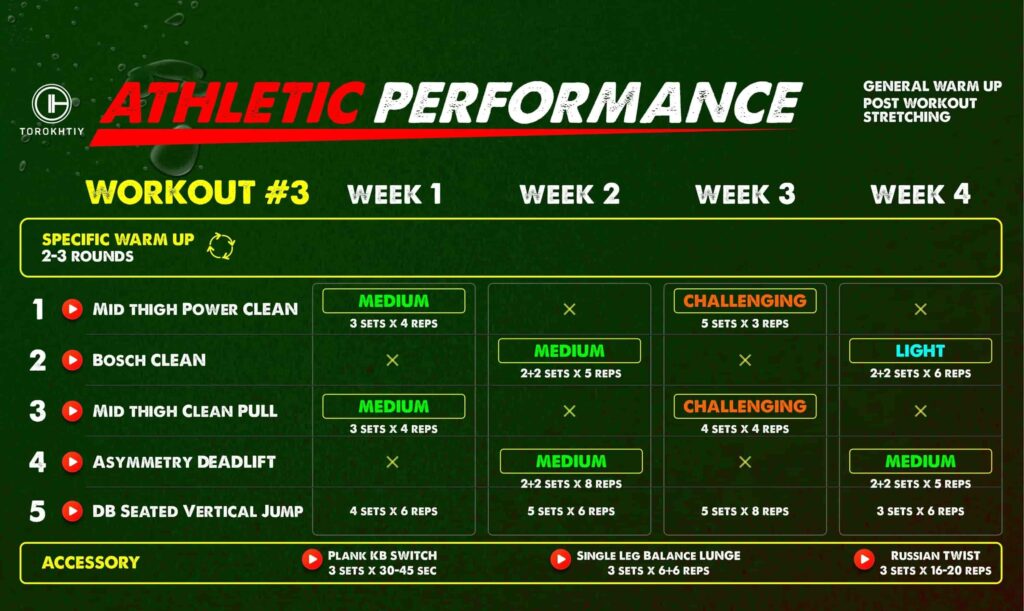
A well-rounded football weight training program also lowers the risk of injury and helps with recovery periods, too.
What Is A Football Weight Training Program? Essential weight training for football has both strength and functionality training. Strength training for football should consist of compound exercises that activate multiple muscle groups at once. Functionality exercises include plyometric drills that develop explosiveness and agility.
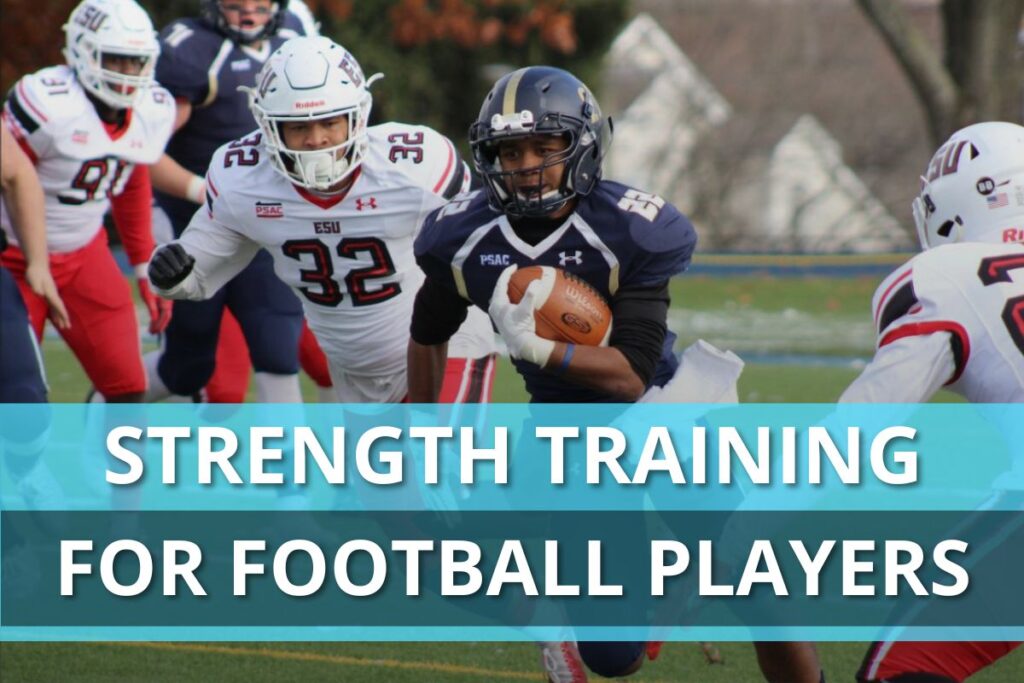
What’s Strength Training For Footballers
Strength training is essential for physical preparation for American football players.
American football players should focus on developing overall body strength and explosive power, particularly in the legs, hips, back, and upper body.
Training these muscle groups helps players generate greater force in essential football movements such as sprinting, jumping, throwing, as well as tackling, blocking, and intercepting opposing players.
Benefits Of Strength Training For Football Players
Core Stability
The core plays a critical role in football performance, providing stability and power transfer between the upper and lower body.
Football involves a lot of twisting, turning, and sudden changes of direction, which puts stress on the core muscles.
Grip Strength
Football involves a lot of grabbing, holding, and pushing.
Having good grip strength is important because it helps players control the ball, maintain possession, and tackle opponents.
Good grip strength improves the players’ ability to direct and catch throws.
Explosive Power
Explosive power is important for football players because it allows them to generate force quickly and effectively.
Football involves a lot of explosive movements such as sprinting, jumping, and tackling, which involves constant speed and directional change.
Explosive power can help a player run faster, jump higher, and hit harder, giving them an advantage over their opponents.
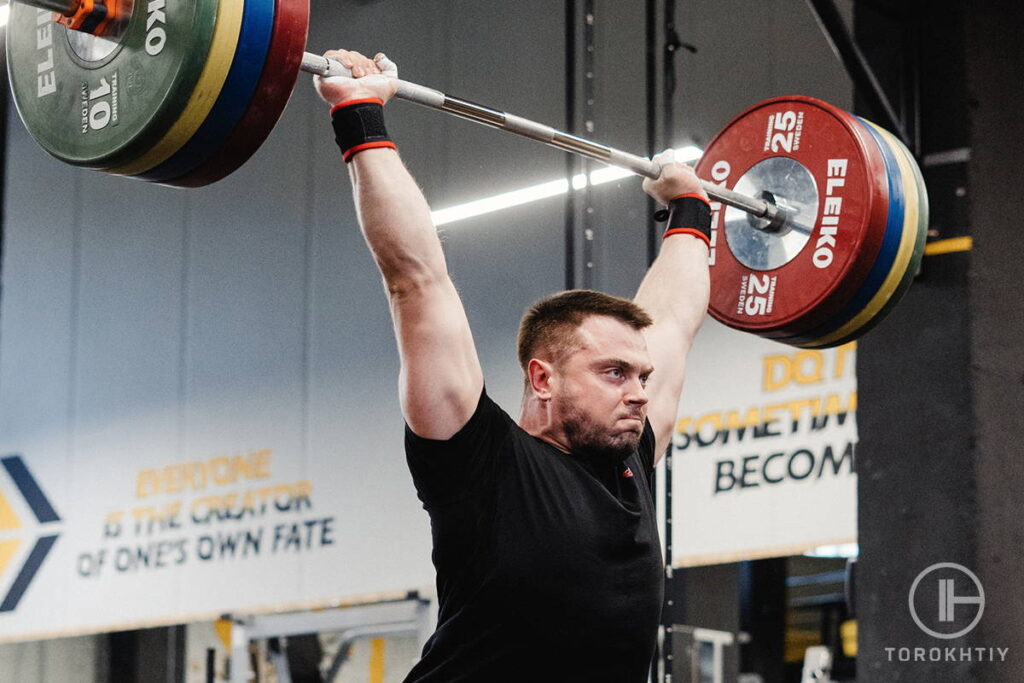
Strength Training Exercises For Footballers
Squats
Squats are the quintessential exercise in any football weightlifting program.
They are a compound exercise that target the lower body – specifically the quads, glutes, and hamstrings.
Squats are great for building lower body strength, power, and explosiveness, which are essential for running, jumping, and tackling – which is exactly what football players want.
There are also infinite variations of squats – such as front squats, back squats, sumo squats, overhead squats, etc. – all of which can be done with or without weights, helping the athlete better target different muscle groups.
Deadlifts
Deadlifts are another compound exercise that target the entire posterior chain, including the lower back, glutes, and hamstrings.
They are one of the best lifts for football strength and power training, since they directly improve a player’s ability to block, tackle, and maintain good posture on the field.
Football players should focus on doing deadlifts for the exercise’s strength benefits, which means they should do them in low repetitions with high weight loads.
Deadlifts also exist in infinite variations, such as the classic deadlift, sumo deadlift, Romanian deadlift, narrow and wide spread deadlift, etc.
Lunges
Lunges are a unilateral exercise that targets the quadriceps, hamstrings, glutes, and core, which are essential for sprinting. Lunges can help improve balance and stability, as it is an exercise that requires control and balance, which can improve your running mechanics.
Lunges can help increase hip mobility, which is necessary for proper running form. It can help improve muscle endurance and lower body strength, which will increase the power and speed during each stride.
Bench Press
The bench press is a classic upper body exercise that targets the chest, shoulders, and triceps.
It’s a great exercise for building upper body strength and power, which is why it’s very popular among athletes who play contact full-contact sports, such as football.
Having a developed shoulder and chest area and strong arms helps players with pushing and blocking movements, helping them overpower the opposing players in close contact.
Bench presses are primarily done with barbells or dumbbells and also exist in variations, including the standard bench press, inclined bench press, decline bench press, close or narrow grip press, etc.
Pull-Ups
Pull-ups are a compound exercise that target the upper back, biceps, and forearms.
They’re good for building upper body strength and power, but more importantly, they’re excellent for improving grip strength.
This helps football players in catching and holding on to the ball, as well as not losing grip of it when it’s contested by an opposing player.
Pull-up variations include, such as narrow or wide grip pull-ups, chin-ups, muscle-ups, etc. – all of which target different upper body muscle groups but primarily train grip strength.
Rows
Row exercises are good for strengthening the muscles of the upper back and shoulders, including the lats, rhomboids, trapezius, and rear delts.
Football players frequently engage in activities that place significant stress on the shoulders and upper back, such as blocking, tackling, and throwing, and strengthening these muscles can help to prevent injury and improve performance.
Row exercises can also improve push and pull motions and grip strength, which is important for holding onto the football or grabbing onto opponents.
There are variations of row exercises that include both barbells, dumbbells, or using something like a resistance band.
Overhead Press
The overhead press is excellent for developing strength, mobility, and explosiveness in the upper body.
It targets shoulders, triceps, and upper back at the same time, making it a compound exercise.
These muscle groups are essential for catching, throwing and intercepting the ball when passing overhead.
Overhead presses are done with weight, so you can use a barbell, dumbbell, or even a sandbag, and they can be done while standing or sitting as well.
They’re also a good lead into Olympic lifting for football, since overhead presses have a similarity to the second part of the Clean & Jerk.
Olympic Lifts
Speaking of Olympic lifts, let’s talk about the Snatch and the Clean & Jerk. Both lifts are excellent compound exercises, since they engage nearly the entire body.
The Snatch is a singular motion exercise where the athlete picks up the barbell from the ground and lifts it above his head, ending in a squat position with hands fully extended upwards.
The Clean & Jerk is a two-part exercise:
Starting with the “Clean”, the athlete lifts the barbell from the ground and catches it from underneath once it reaches shoulder level.
For the second part of the exercise, the “Jerk”, the upper body motion is similar to the Overhead Press, except we dip in and push with our legs and hips to add momentum and strength.
The exercise is complete when we’re in a standing position, with the barbell over our head held by fully extended arms.
Farmer’s Walks
Farmer’s walks are a functional exercise that target the grip, forearms, and core.
They’re great for improving overall strength and stability while under weighted pressure, which can benefit players in both performing and defending against tackles.
Farmer’s walks are very conventional as you can do them either with proper exercise equipment such as Trap bars, kettlebells, or dumbbells, or you can use household items such as water gallons.
Sled Pushes/Pulls
Sled pushes and pulls are functional exercises that target the legs, hips, and upper body.
They improve cardiovascular fitness and endurance, which is necessary for sustaining high-intensity efforts during games and practices.
The exercise puts the body in a near-vertical position to the floor, and practices movements and muscle groups that will improve the players ability to win out in duels with opposing players.
If you don’t have a gym sled, you can use a wall or another solid, immovable object as a substitute.
Simply push against or hold onto the solid object from the same starting position as you would with a sled, and walk in place forwards or backwards while allowing your feet to slide on the floor, to feel the weighted resistance.
Calf Raises
Calf raises exercise the calves and surrounding lower leg muscles.
These muscle groups are essential for explosive power, balance, and agility.
This helps the player stay on their feet, make rapid direction changes, and turn around quickly and efficiently.
Calf raises are great as they can be done in a variety of ways, including standing or sitting down, and require nothing more than a pair of dumbbells for added resistance.
Box Jumps
Box jumps are an excellent exercise for football players since they improve explosive power and develop fast-twitch muscle fibers, which are essential for sprinting, jumping, and tackling.
Additionally, box jumps improve agility, balance, and coordination, which are important traits to have on the football field.
If you don’t have a box to jump on, you can use any elevated space, as long as it has a wide landing surface that isn’t slippery.
When I don’t have a box on me, I stack a couple of 55 lbs weight plates.
By adding or removing plates, I also get to set the height of my jump – so feel free to steal this tip from me.
If you get tired or find the surface too stiff to jump on, box climbs are a perfectly fine substitute as well.
Key Factors In Footballers’ Strength Training Routine
Low-rep Compound Exercising
The best workouts for football players involved compound exercises with high weight and low repetition, which build muscles and strength quickly and efficiently.
The best compound exercises include deadlifts, squats, bench presses, and similar essential lifts such as the Snatch and Clean & Jerk.
Sport-Specific Movement
When designing a training routine for football players, it’s important to incorporate exercises that mimic movements players experience on the field.
That way exercises are not only developing the player’s strength, but crucial muscle memory as well.
Follow us!

Free!
Get a 2-week Weightlifting Program as a bonus for the subscription to kickstart your training plan!

Free!
Functional Exercises
Apart from strength training, it’s important to mix in exercises that improve the players stamina, agility, explosive power, and speed.
Plyometric drills are an excellent and efficient way of doing this, as they’re fairly high impact while not taking too much time as, for example, running long distances.
Proper Recovery
Resting periods are just as important for body development as exercising.
Football is a full-contact sport and improper healing can lead to severe issues down the line, which can be career-ending in some cases.
Active recovery is a good way to stay warmed up between training days, too.
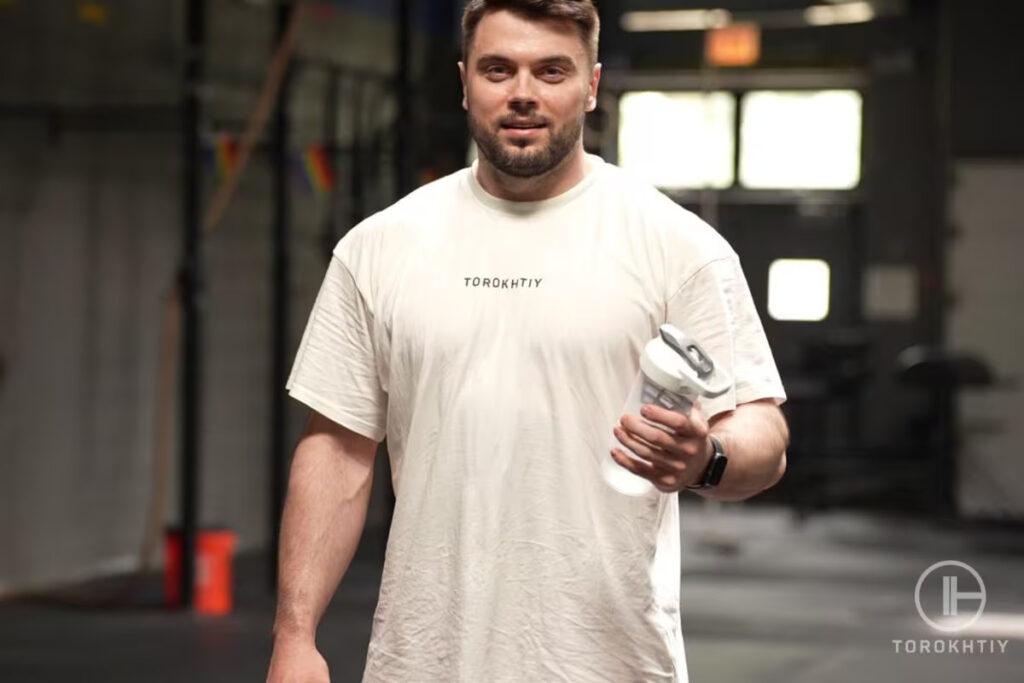
Footballers Strength Training Program
Here’s how an essential football player training program might look like.
It follows a 7-day (weekly) schedule that has everything from football workouts with weights, bodyweight training, functionality exercises, and active recovery.
The great thing about this program is that you don’t need constant access to the gym to follow it.
The workouts contain basic exercises which can be done at home and require minimal workout equipment, some of which you can find DIY solutions for if you’re creative.
If you have access to a high-end gym, feel free to adjust it using specialized equipment.
Note that in this specific program I put lower body exercising on days one and four, and upper body exercising on days two and five.
However, you can switch days one and two and four and five (swap lower and upper body days) depending on your personal schedule, as well as your team’s practice days.
Monday (Day 1) – Lower Body
The reason why it’s a good idea to start the week off with lower body exercises, is you want more recovery time for your lower body before the weekend, when most football matches are played.
Here’s an example lower body exercise routine:
- Squats: 3-4 sets of 6-8 reps
- Romanian Deadlifts: 3-4 sets of 6-8 reps
- Forward Lunges: 2-3 sets of 10-12 reps per leg
- Reverse Lunges: 2-3 sets of 10-12 reps per leg
- Calf Raises: 2-3 sets of 10-12 reps
Tuesday (Day 2) – Upper Body
On day two we’re focusing on developing upper body strength.
This means not only building muscle, but also practicing our grip and push/pull motions.
- Bench Press: 3-4 sets of 6-8 reps
- Pull-Up Variations: 3-4 sets of 6-8 reps
- Overhead Press: 2-3 sets of 8-10 reps
- Incline Bench Press: 2-3 sets of 8-10 reps
- Dumbbell Rows: 2-3 sets of 10-12 reps per arm

Wednesday (Day 3) – Rest or Active Recovery
Taking a break from training is equally as important for your performance as the exercises themselves.
It helps your muscles recuperate and cool down, which also allows you to spot any issues or injuries.
The NFL recommends their players take at least 48 hours of rest between training each muscle group. Your rest day can also include an hour or so of active recovery training.
Active recovery includes low-intensity exercises or activities meant to keep the body warm and engaged during the recovery period between high-intensity training sessions.
These exercises include things such as light jogging, yoga, stretching, or low-intensity resistance training.
These activities promote good health by increasing blood flow, reducing muscle soreness, and are mentally relaxing as well.
- Bench Press: 3-4 sets of 6-8 reps
- Pull-Up Variations: 3-4 sets of 6-8 reps
- Overhead Press: 2-3 sets of 8-10 reps
- Incline Bench Press: 2-3 sets of 8-10 reps
- Dumbbell Rows: 2-3 sets of 10-12 reps per arm
Thursday (Day 4) – Lower Body
Day four is essentially a repeat of day one, but we’re making slight adjustments to target different muscle groups, and adding some functional training as well.
- Deadlifts: 3-4 sets of 6-8 reps
- Box Jumps: 2-3 sets of 8-10 reps
- Farmer’s Walks: 2-3 sets of 20-30 seconds
- Sled Pushes or Pulls: 2-3 sets of 20-30 seconds
- Walking Lunges: 2-3 sets of 10-12 reps per leg, forward and backwards
Friday (Day 5) – Upper Body
On day five we’re doing our final set of exercises before our first true rest day from our football lifting program.
- Bench Press: 3-4 sets of 6-8 reps
- Pull-Up Variations: 3-4 sets of 6-8 reps
- Overhead Press: 2-3 sets of 8-10 reps
- Incline Bench Press: 2-3 sets of 8-10 reps
- Dumbbell Rows: 2-3 sets of 10-12 reps per arm
Save it for easy access!
Bookmark this page now to access the program and instructional videos anytime, anywhere.
Stop wasting time searching during your gym sessions.
Saturday (Day 6) – Rest
On day six, I highly recommend taking your first true day of rest to let the body relax and recover.
It’s widely known in the fitness community that resting periods are important for reducing muscle fatigue and injury prevention, and data can back this up.
A study done on U.S. Army trainees over a 12-month period showed that spending greater amounts of time weight training led to a higher likelihood of injury.
Additionally, overtraining yourself leads not only to physical, but mental fatigue as well.
Research has shown mental fatigue can significantly lower athletic performance, leading worse results on the field and making us more prone to injury and exhaustion.
Sunday (Day 7) – Full-Body Conditioning
On our final training day of the 7-day program, we’re focusing on high-intensity activities that get our heart pumping and push our cardiovascular limits. These exercises should make you sweat and promote high blood flow, which helps detoxify our body.
Here are some examples:
- Jumping Jacks, Burpees, Jump Squats (or other plyometric exercises): 2-3 sets of 10-12 reps
Sprints or Shuttle Runs: 5-10 sets of 10-20 seconds
If you have the necessary equipment for it, you can also add the following:
- Medicine Ball Throws or Slams: 2-3 sets of 8-10 reps
- Battle Ropes: 2-3 sets of 20-30 seconds
- Jump ropes: 2-3 sets of 30-60 seconds
My personal favorite way to finish out a full-body conditioning training day is combining some of these exercises into Tabata Circuit. Tabata exercise is a high-intensity interval training (HIIT) workout that consists of short, intense bursts of exercise followed by brief rest periods.
Tabata workouts consist of 8 rounds of 20 seconds of intense exercise, followed by 10 seconds of rest. You can adjust the number of rounds and second to better suit your workout, however, the general goal is for the exercise to add up to 4 minutes.
Combine five exercises into this routine and you have yourself an explosive workout routine that can be done in half an hour or less. There are also plenty of Tabata music tracks that will motivate you and do the necessary counting, so you can focus on the workout.
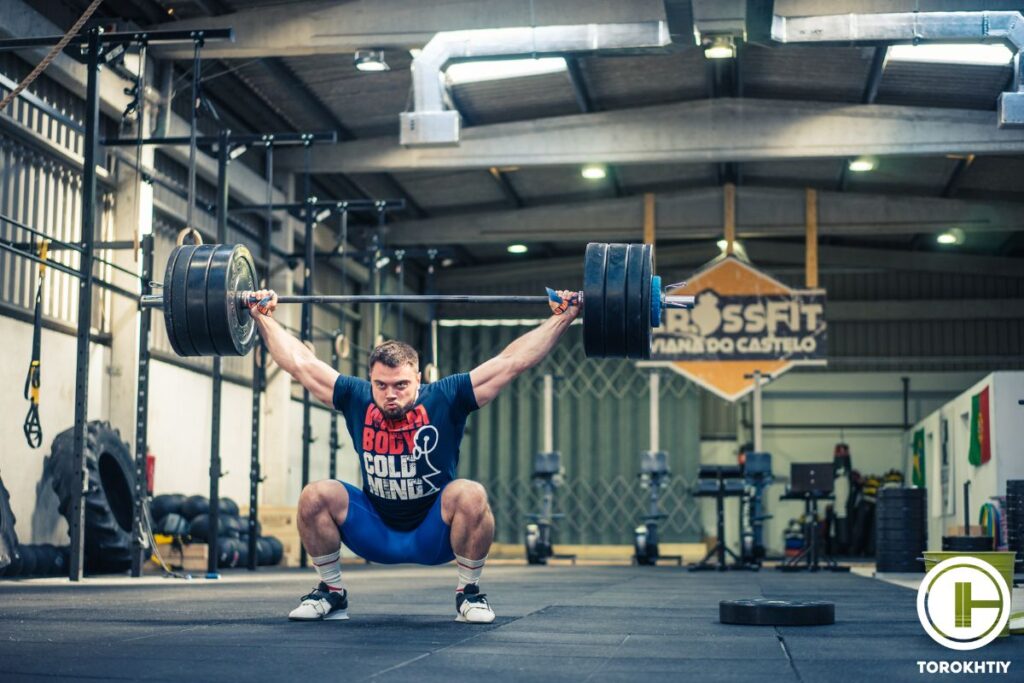
Basic Equipment You Need For The Program
The great thing about this program is, with a bit of creativity and DIY, you won’t need special fitness equipment to do it.
However, having it or having access to a gym or training facility with it is certainly beneficial.
Here’s a short list:
- Squat rack or other power rack
- Exercise bench
- Pull-up bar (mounted or doorway jammed)
- Barbell and weight plate set
- Dumbbell set
- Kattlebell set
- Exercise mat
- Weighted sled
- Plyometric box
- Optional: trap bar, battle ropes, medicinal balls, resistance bands, jump rope
FAQ
What Type Of Weight Training Should Footballers Do?
NFL players focus on a combination of compound exercises that target multiple muscle groups, such as squats, deadlifts, and bench presses, as well as exercises that specifically target the muscles used in football movements, plyometrics, push/pull exercises, and agility drills.
How Many Days a Week Do Football Players Lift Weights?
It depends on the part of the season, as well as the athlete’s personal and professional goal.
During regular season, most American football players lift two times a week, according to American Football International
How Many Reps Do Footballers Do?
The number of exercise repetitions that American football players do depends on their specific training goals and the type of exercise being performed.
Generally, for strength training, American football players perform sets of 6-12 reps per exercise with heavy weight loads.
For explosive power, agility, and speed, players mostly perform plyometric exercises with higher reps and shorter rest periods.
Conclusion
Football is a full-contact sport that requires athletes to be strong, agile, fast, and precise.
A well thought-out football weight training program is just as important for players as functionality and stamina training.
The essential program provided in this article covers all the basics, but you’re free to play around with it to better fit your schedule and goals.
Do you play football (professionally or recreationally)? Do you exercise as well as play? I’d love to hear your experience in the comments. As always, remember to follow me on social media for more fitness content.
Also read:
- Weightlifting for Baseball Players
- Strength Training for Hockey Players
- Strength Training for BJJ Fighters
- Strength Training for Volleyball Players
- Strength Training for Golf Players
- Strength Training for Rowers
- Battle Rope Benefits
- Weight Bench Guide
References:
- 5 Tips and Tricks to Train Like an NFL Player // American Football International: https://www.americanfootballinternational.com/5-tips-and-tricks-to-train-like-an-nfl-player/
- Do’s and Don’ts for your summer workou // NFL: https://www.nfl.com/news/do-s-and-don-ts-for-your-summer-workout-0ap2000000367058
- Injury Risk Factors Associated With Weight Training // NCBI: https://pubmed.ncbi.nlm.nih.gov/32796416/
- Endurance exercise-induced and mental fatigue and the brain // NCBI: https://pubmed.ncbi.nlm.nih.gov/32176398/
- Tabata vs. HIIT: What’s the Difference? // Cleveland Clinic: https://health.clevelandclinic.org/tabata-vs-hiit-whats-the-difference
- Photos made by Torokhtiy Media Team; football wife, Pexels.
Why Trust Us?
With over 20 years in Olympic weightlifting, strength training, nutrition coaching, and general fitness our team does its best to provide the audience with ultimate support and meet the needs and requirements of advanced athletes and professional lifters, as well as people who strive to open new opportunities and develop their physical capabilities with us.
By trusting the recommendations of our certified experts in coaching, nutrition, and sports training programming, as well as scientific consultants, and physiotherapists, we provide you with thorough, well-considered, and scientifically proven content. All the information given in the articles concerning workout programming, separate exercises, and athletic performance, in general, is based on verified data.
The product testing process is described in more detail here.
Author: Sergii Putsov
Head of Sport Science, PhD
Best Results: Snatch – 165 kg,
C&J – 200 kg
Sergii Putsov, Ph.D., is a former professional weightlifter and National team member, achieving multiple medals in the 94 kg weight category at national competitions. With a Master’s degree in “Olympic & Professional Sport Training” and a Sport Science Ph.D. from the International Olympic Academy, Greece, Sergii now leads as the Head of Sport Science. He specializes in designing training programs, writing insightful blog articles, providing live commentary at international weightlifting events, and conducting educational seminars worldwide alongside Olympic weightlifting expert Oleksiy Torokhtiy.
Reviewed by: Oleksiy Torokhtiy
Olympic Weightlifting Champion, PhD in Sport Science
Best Results: Snatch – 200 kg,
C&J – 240 kg
Oleksiy Torokhtiy is a professional athlete boasting 20 years of experience in Olympic weightlifting. With multiple European and World titles under his belt, he has showcased his prowess in two Olympic Games (Beijing 2008 and London 2012). Upon concluding his illustrious career, Oleksiy dedicated himself to coaching. By 2022, he had conducted over 200 weightlifting seminars worldwide. He is the visionary behind an international sportswear and accessories brand known for its motto, “Warm Body Cold Mind.” Additionally, he is an esteemed author and the creator of a series of training programs and eBooks.






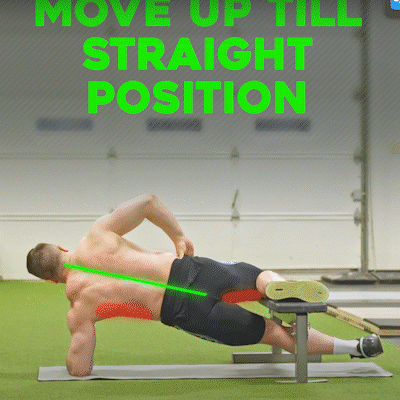
Still have questions after reading our article? Unlock your full potential by engaging with our experts and community! Don’t hesitate — leave a comment below and Sergii Putsov will provide a personalized answer and insights to help you reach your goals.